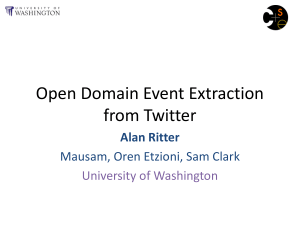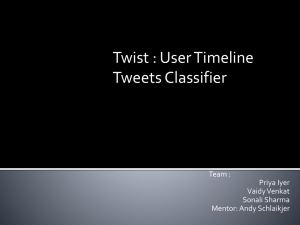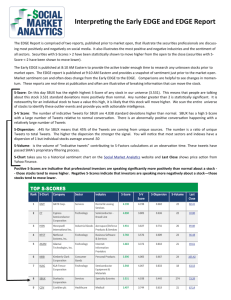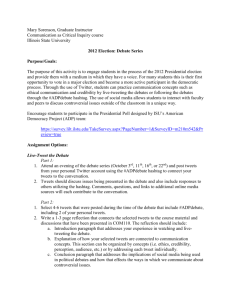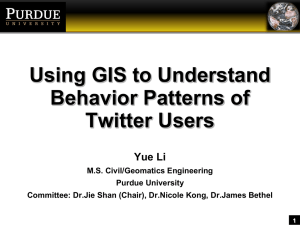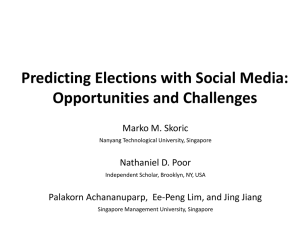NSF CDI meeting - University of Illinois at Urbana
advertisement
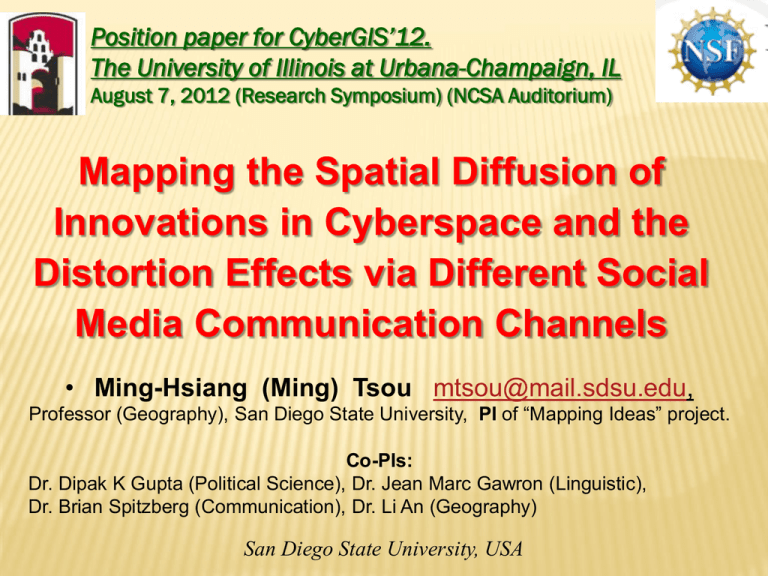
Position paper for CyberGIS’12. The University of Illinois at Urbana-Champaign, IL August 7, 2012 (Research Symposium) (NCSA Auditorium) Mapping the Spatial Diffusion of Innovations in Cyberspace and the Distortion Effects via Different Social Media Communication Channels • Ming-Hsiang (Ming) Tsou mtsou@mail.sdsu.edu, Professor (Geography), San Diego State University, PI of “Mapping Ideas” project. Co-PIs: Dr. Dipak K Gupta (Political Science), Dr. Jean Marc Gawron (Linguistic), Dr. Brian Spitzberg (Communication), Dr. Li An (Geography) San Diego State University, USA Funded by NSF Cyber-Enabled Discovery and Innovation (CDI) program. Award # 1028177. (four years 2010-2014) http://mappingideas.sdsu.edu/ Special thank to our wonderful graduate students and undergraduates: Current (2012): Ph.D. Students: Ick Hoi (Rick) Kim, Jiue-An (Jay) Yang, Sarah Wandersee, Ninghua Wang. Master Students: Daniel Lusher, Anna Nagel, Nicole Stotz, Undergraduates: Alejandra Coronado. 2010 - 2011: Kellen Stephens, Ting-Hwan Lee, Amit Nagesh, Vickie Mellos, Jennifer Smith, Luke Kemper, James Banker. DIFFUSION OF INNOVATIONS THE INNOVATION DIFFUSION MODEL (E. Rogers, 1962): Diffusion: “a special type of communication concerned with the spread of messages that are perceived as new ideas” (E. Rogers, p. 35). Torsten Hägerstrand, 1953 – Doctoral Dissertation - Culture Diffusion. 1967 Innovation Diffusion as a Spatial Process. Public (Mass Media, TV, News) vs. Private (Personal Communications) Can we apply this diffusion theory in Cyberspace? Example: Occupy Wall Street ? Source: http://www.economist.com/blogs/democracyinamerica/2011/10/socialmedia-and-wall-street-protests Mapping Social Media and “Ideas” on Digital Earth. Can we create a “new method” to understand and analyze social activities, ideas, and human communications on our digital Earth? (revealing the invisible world)? Similar to the “remote sensing satellites” or “social radar” to monitor human activities on our Earth. This new method will help us to detect: • Image created by Ming-Hsiang Tsou (NSF-CDI project) The location of 1000 web pages with keyword “white powers” from Yahoo Search Engine on October 15, 2010. Social Weather Maps Create “ ”? (monitoring social “temperature” changes, social “storms”…) • Hot spots of ideas, events, or concepts. (social storms?) Dynamic changes of social activities, ideas, events, and social movements. (change of social weather maps) Spatial Web Automatic Reasoning and Mapping System (SWARMS ) prototype Information Communication Channels in Cyberspace • Web Pages ( Semi-Public Information Communication ) • Social Media (Twitter: Semi-Private Information Communication) Web Pages: Use Web Search Engines (Google, Yahoo, and Bing) to retrieve up to 1,000 web pages per keyword. Then analyze their contents associated with their ranks and geolocations. Social Media (Tweets): Use Twitter APIs to retrieve tweets based on Keywords or #Hashtag and geolocations (self-defined home-towns or GPS locations). Collect Web Page Contents, Ranks, and Locations: We develop Cyber-Discovery Search Engine (Retrieve up to 1000 results from Yahoo or Bing) “Burn Koran” Web Information Landscape The kernel density of “burn Koran” points (keyword search results) from 1000 associated websites (red dots) Yahoo search engine on January 30, 2011. The kernel density of 50,000 web pages from 300 random keywords. (Baseline map) “burn Koran” of Web Information Landscape Baseline (average) of Web Information Landscape Differential of Web Information Landscape Social Media (Tweets) –Semi-Private Communication: Use Twitter APIs to retrieve tweets based on Keywords or #Hashtag and geolocations (self-defined home-towns or GPS locations). Twitter An online social networking service A micro-blogging service Created in March, 2006 Reached 300 million users as of 2011 Over 300 million tweets per day Over 1.6 billion search queries per day Twitter Application Programming Interface (API) For software to communicate with other programs Search API: query for Twitter content + spatial query function. Streaming API: real-time data trend mining TWITTER – SPATIAL SEARCH API Center: 41.961295, -93.281859 Radius: 180 miles Limitations: 1. Spatial Search can only trace back up to seven days. (Regular search can trace back to 14 days.) 2. Each search results can not exceed 1500 tweets. Tweets Search Keyword: “Mitt Romney” Output contents export to Excel files (.xls) Tweets% (one day before), tweets% (election day), and the Actual Election Results% Sometimes the one day before tweets% is closer to the actual election results. Ron Paul % has very big “distortion” comparing to the actual results. All cyberspace maps are “distorted from the real world due to the “projection methods” -communication methods or media characteristics. Different Topics Real World Different Projection Methods (Distortion) What kinds of “distortion”? • Explanation • Space-Time Analysis • Prediction? Correct the distortion effects Epilogue: Big Brother (1984)? What types of ethical and civil-liberty implications (in terms of privacy, security and human rights) will need to be considered in the context of Web surveillance technologies and the analytical tools of web and social media? Thank You mtsou@mail.sdsu.edu Funded by NSF Cyber-Enabled Discovery and Innovation (CDI) program. Award # 1028177. (four years 2010-2014) http://mappingideas.sdsu.edu/

